Getting bug out gear begins with getting the best bug out backpack for you and then selecting what you carry based on how much space you have and what you can carry. This makes for careful decision-making, balancing the need to cover all bases (sometimes with redundancy) while simultaneously not overdoing it. Let’s look at one piece in this article – selecting the best flashlights for bugging out.
Most of us have that sinking feeling that the end will arrive somewhere between a bang and a whimper. It likely won’t be a mushroom cloud on the horizon, nor will it be a slow steady predictable slide over the edge. Regardless, when or where it arrives, other than a knife and fire starters, the flashlight just might be the second most important piece of bug out gear to get you to the next step.
And since there is a 50% chance that darkness will be the dominant condition in which you need to move, a light is essential. In fact, odds are probably even greater than 50/50 you’ll be in the dark. First, there is a general 50/50 chance of operating at night, but also consider the need to venture inside a structure with no electricity. Regardless, it’s clear – every serious prepper needs a serious bug out light!
What do You Need from a Bug Out Flashlight?
Defining needs is the place to start with any type of equipment, but with a hypothetical bug out situation, the needs are fairly clear. The best flashlights for bugging out are not going to be spotlights, no heavy D-cell Maglites, etc. A flashlight for bugging out has to balance weight and size with power and battery life.
Bugging out – in many cases – involves either the intent to, or ability to, travel on foot. You might plan to bug out by vehicle, but you always need the option to venture out on foot. You have to expect the unexpected. Your vehicle could break down. You could find traffic gridlock that doesn’t move. You could run out of gas. It doesn’t matter, you need an on-foot option, and that’s why you need to consider a light’s weight and size.
There is something else – the need to be discreet. This is discussed less often, and that is unfortunate. Take my suggestion above, that you may very well have to enter a building that lacks electricity. A bug out situation almost certainly means a dangerous situation. You don’t want to attract unwanted attention.
You need a light that can not only light up everything you need to see in front of you, but that can also power down enough to see just what you need to see. In other words, you want to limit your light signature to only what you need.
Light the Night
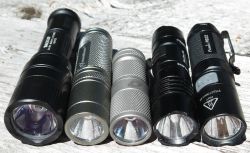
My quest for a powerful, durable, and dependable EDC flashlight began decades ago. Long before the 1984 release of the AA battery Mini Maglite made flashlight EDC carry a household practice, I was searching for solutions in the dive light world. Tekna produced two AA flashlights that were as durable as they were bulky. With heavy ABS plastic bodies and overbuilt screwdown bezels, the lights had potential, but were severely limited by their traditional incandescent bulbs. I hot-rodded my 4-AA Tekna dive light with a halogen bulb and gold washers, and thought I was king of the night with my photon firepower.
The two-AA Mini Maglite revolution of the 1980s spurred a rush for high powered pocket-sized lights. Many other companies dove in, but until LED technology became affordable, all small lights were crippled by short battery life, fragile glass bulbs, and the most obvious, a low lumen count. Maglite raised the bar further with its Solitaire single AAA flashlight in 1988, except that bar didn’t stay high for long since the notoriously unreliable Solitaire was carried on keyrings far more than it was ever lit up.
When LED technology entered the mainstream marketplace, major flashlight manufactures seemed caught off guard. In true paradigm shifting fashion, some of the big guns in illumination were left in the dark as smaller more nimble companies flooded the market with higher lumen, long battery life flashlights for a similar cost to upper end traditional bulb lights. Maglite released its first LED light in 2006, but quickly noticed that many folks who carried the classic D-cell lights were as interested in the flashlight-as-a-club as it for a flashlight. It quickly became apparent that the power-sipping LEDs did not require a foot-long supply of batteries. But by then, the genie was out of the bottle and Maglite’s name was now synonymous with old-school.

A parallel revolution was also taking place in camera technology. As film cameras and their early digital offspring developed ever more voracious appetites for electricity, both battery manufactures and the paying public developed a taste for powerful lithium-based batteries over their alkaline and carbon siblings. Add in CNC machining, the drugstore availability of high-end batteries, advances in LED light color and intensity, and a few disgruntled workers leaving major flashlight companies to give it a go themselves, a literal explosion of flashlight tech appeared on store shelves, but mostly through online retailers.
And in true tech form, the microprocessor-controlled advanced lighting solutions came with complex multi-stage interfaces, regulation circuits, timed and sequenced lighting options such as strobe and SOS, and a Moore’s Law of its own doubling lumens at a predictable rate.
Where we were once satisfied with 20 lumens, we quickly wanted 100, then 200, then 500, then a thousand! We could literally carry a car headlight worth of light in a pants pocket. But alas, it came at a cost both in terms of money and runtime. This first Flashlight Wisdom installment will address the single-123 LED flashlight along with a healthy salting of flashlight wisdom.
The shockingly small but powerful 123 battery has given flashlight designers, among many other technologies, a modern tool with which to pump electrons into something whose primary mission in life is to produce light. While the 123 batteries seem more expensive, they are actually cheaper then their lithium AA counterparts. And the advantages of a lithium-based battery include a decade of shelf-life, and a far greater operational temperature range. Other than cost, the only other downside is the increased risk of explosion and fire, so much so that in 2013 the TSA and Postal Service implemented restrictions on the carry and shipping of lithium batteries.
But TSA and USPS aside, the true goodness of the 123 battery really shines in the single-cell EDC flashlight. Some companies are producing flashlight that are not much larger than the battery itself, while others are able to stuff a mind boggling number of lighting choices into a light the size of your thumb. Of course that latter option comes with a programming interface that will require some homework to operate.
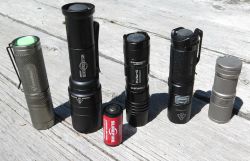
A handful of single-cell 123 LED lights were chosen for this article. Represented are models from Surefire, Streamlight, 4Sevens, ExtreameBeam, and Fenix. This is not a specific review of each light but rather more of a comparison of options and designs that should help you decide on what flashlight in this EDC lighting space will best serve your lighting needs. Since the flashlights are all of quality, have high (enough) lumen counts, run on the same single battery, and are backed by customer service and a warranty (mileage may vary), we will focus on the operation, features, and differences of the lights with a general sprinkling of opinions based on real-world carry.
Lumen Madness
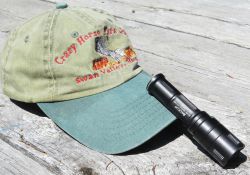
Let’s get this out of the way first. The lumen number is an indication of how bright the flashlight is, but not how far the beam will go or how much spill to the sides. Nor does it indicate the purity of the light such as the color or if artifacts like rings, hotspots, or LED squares are visible. But high lumen numbers sure do sell flashlights. Real world lumen numbers are important, but the knife cuts both ways. While large sells, low lumens extend battery life. I have a triple-123 Surefire Fury that has a 20 lumen first stage and a 1000 lumen second. If I need to blind someone at a thirty yards, I can do it. But 99% of the time, 20 lumens is plenty. Even five lumens will get you through most tasks if it’s dark enough to really need a light.
For output adjustability, my preference is the Fenix. It uses a small rubber mode switch on the bezel, and a tailcap on/off switch. So the Fenix is easy to cycle through the brightness options during a natural hold. And it remembers your last choice so if you put the light to bed on high, it will wake on high. Or my preference, low on low.
Size Matters
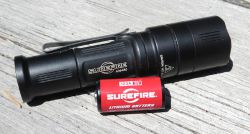
Of these five lights, the Surefire is by far the largest, and the 4Sevens is by far the shortest. The 123 battery is about an inch-and-a-quarter long. The 4Sevens is twice that length at 2.5 inches, and the Surefire almost doubles that stretching out to near four-and-a-half inches or three-and-a-half times the length of the battery. While the Surefire is arguably the world’s largest single-cell 123 flashlight, the 4Sevens is not the smallest, but it does seem like it. The other lights in this comparison all hover around 3.5 inches.
For carry, small is good. However, the use of a flashlight involves actual activity beyond just transporting. As a light gets smaller, it loses more than size, it also loses mechanical switches, lanyard attachments, and bezel options. In the case of the 4Sevens, its switch is a twist of the bezel. While possible one-handed, the programming interface of the 4Sevens is definitely a two-handed job. Further, while the light can be off, a slight pressure compressing the head to body will fire up the flashlight whether in pocket or pack unless unscrewed far enough.
Compared to a tail switch, the twist-to-light is less convenient. On a good note, however, the light can be pulsed by pushing on the bezel, but without a further twist, the light will go off the moment pressure is released.
Some tail switches like that on the ExtremeBeam glow in the dark. It makes for easy identification but only if the little green switch cover has eaten enough daylight to illuminate until needed. Also, the ExtremeBeam is an all-or-nothing interface. One speed; full blast. Great for blinding bad guys point blank, but not good for sipping volts to ride out the storm.
Under Pressure
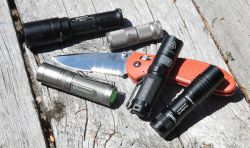
Something to keep in mind here is that waterproof flashlights are air-tight in both directions. That means that if your batteries off-gas, they will pressurize the inside of your flashlight. Usually this is not much of an issue except when the rubber cover over the tailcap switch swells like a balloon. Then it can be difficult to depress the switch. The quick fix is to unscrew the light releasing the pressure. Then note the type of batteries since some are more prone to off-gassing than others.
Runtime varies across lights, but you should hope for an hour at full speed, and many hours, even 10+ when running in low gear. Between five and 20 lumens is enough to navigate at night, but you will need the higher side of that low range when lighting for a group of folks.
Most newer LED lights step down their output to match the available battery power. That means that while the maximum output might 500 or 1000 lumens, it won’t last long. Then output will drop off along a shallow slope until zero. So after a few tens of minutes of running on fresh batteries, the difference between high and low will not be as dramatic. A few tens of minutes more any you might not be able to tell the difference between high and low. I’m told it’s a feature, not a bug.
And finally, regarding battery life, I have learned to avoid those lights that feel a need show their lower voltage by blinking every so often. For me, that almost makes the light useless at that point except for walking in the dark. So what the manufacturer thought was a good idea actually lessened the battery’s service life due to the programmed-in strobe distraction. You will need new batteries when the light dims significantly or goes out. I thought everyone knew that. Got a single cell like you love? Tell us about it in the comments below. – Stay tuned for Part 2.
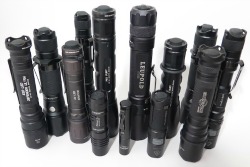
I can tell that the dust has not yet settled on flashlight interfaces in the same way it has not yet to settle on computer operating systems, gun safeties, and even knife blade locking mechanisms. I have three different flashlight switch options in the same brand of flashlight. And another light that has a user-specified programmable interface that you access with three quick twists of the bezel. I had to get YouTube help just to figure out how to program my light.
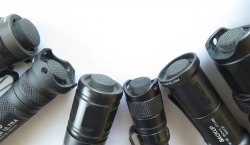
But in the end, this is all for you. Once you go down the rat hole of choice, there is no end to the possibilities when there’s no limit to money and electric circuits. I’ve got variable 0-100 lumen lights, high-low, low-high, single speed, three-speeds, and even considering Surefire’s new line of “IntelliBeam Technology” actually does the brightness adjusting for you depending on how much light is already falling on the scene. I guess it means I’m old if I had to stop and think about that one.
A big choice with the switch is whether or not the light can be turned on using a flat surface instead of a thumb. Recessed switches can prevent unintentional activation of the light, while protruding switches allow the light to be activated with a crude tap on the butt. Both have their place. I prefer shrouded switches, but find that exposed buttons are great for brief on/off lighting and weapons lights. Also, exposed switches usually prevent the light from standing on its tail for a feeble attempt at general area lighting. And in Surefire’s absurd fashion, they managed to make some of their tail switches peek out above the shroud enough to prevent solid tail standing, but not enough to activate the light. Some of those engineers in Fountain Valley really need to get out more.
Other brands have split the difference shrouding only 50% of the tail switch in two 25% barriers on opposite sides of the ring. A flat surface cannot activate the light, but any smaller protrusion can be used as a surrogate thumb. Of course tail-standing with that design is out of the question.
Programming Interface
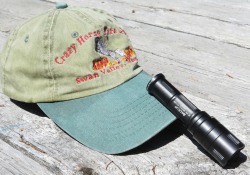
The choices within any individual flashlight can be a simple on/off, to a complex multi-bright-multi-strobe-SOS programmable interface. Or anywhere in between. There are three considerations when thinking about the interface. The first thing to think about its if the interface is even necessary for your needs. Some lights like the 4Sevens are programmable and then hold the lighting sequence until changed. Other brands require a specific set of clicks on a switch meaning both that the choice can be ignored or must be memorized. Other than that, it’s a crapshoot as to what will happen when a user tries different click or twist combinations. Maybe something, maybe nothing. Maybe the worst possible choice for the situation.
The second consideration about the interface is which way you want it to cycle. Defensive lights cycle from brightest to dimmest while utility lights cycle from dim to bright. Other lights might cycle through a series of dim to bright to strobe, etc. All lights have their advantages, but you will need to carry the the light that best needs you anticipate. Personally, I prefer only two stage lights that have low or brightest or brightest and low. The Surefire Fury goes from 20 lumens on first click to 500 on second click. My Surefire E2D Defender goes from 500 lumens on first click to 5 lumens on the quick second click. Both have their place in my daily carry.
And the third is consideration has to do with if the interface is if it’s something that you actually memorize. For instance, the 4Sevens lights have a triple rotation of the bezel to access the interface before you can fiddle around to what the blinking light means. Other interfaces, like the Streamlight, might be as simple as clicking through the secondary bezel-mounted button, or with a set of quick-clicks of the tail switch. Some other lights have rotating bezels with different features, while others have different degrees tailcap depression.
As much as I’m a fan of modern technology, I like a simple, predictable interface that I can toss across the room to a child when necessary that will work 100% of the time. For me, that’s Surefire and Fenix. However I do love my small 4Sevens lights and use Streamlight AA, AAA, and CR123 lights in Bug Out Bags, Truck glove boxes, and daily carry. But trust me, when the S H’s the F, I’ll grab my Surefires first, no questions asked.
Bezel Design
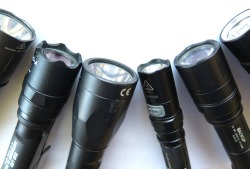
The Bezel is the business-end of the flashlight. It is responsible for the light throw, the shiny reflection, and in some cases, the sharp rim or crenulations that can crack skulls, scrape DNA, and inform those nearby that the light is on when face-down on a smooth surface.
The reflector inside a flashlight can be smooth, rough like an orange peel, or of high-tech geometry blasting the beam in an efficient and desired way. Orange peel reflectors are the new hotness. Long gone are the hot spots and dark spots of the D-cell Maglites. The new norm is uniform light spread across the entire landscape. Seriously, if you haven’t yet experienced quality in hand lighting projection, then you’re in for a pleasant surprise. There is a reason some light cost over a hundred bucks and it’s not just the American fingerprints all over the manufacturing.
Crenulated bezels, or those with raised bumps like the turrets of a castle or scallops on a knife blade, are both fighting weapons and essential indicators of when the light is on, but face down on a flat surface. The raised regions of bezel, or crenulations, make tiny dull knives that focus the impact onto a smaller sharper surface when shoved into flesh. And the spaces between the crenulations allow light to seep out indicating that the batteries are in use but going nowhere. Frankly, I am surprised how many times I encounter a face-planted flashlight dumping photons into a tabletop, countertop or floor. It seems everyone but me parks a running light down on its lens.
Pocket Clip
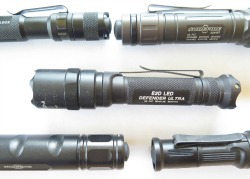
The thin metal strips of spring steel that parallel the flashlight’s body are a simple idea that just cannot seem to evolve beyond its knuckle-dragging stage in life. Flashlight pocket clips, not unlike folding knife pocket clips, run the gamut from passing usefulness to better-off-without-it. The clips vary widely in design, shape, grip strength, direction, and location. Some even play both sides and don’t work well in either direction, while others have mastered the skill of ineffectiveness in only one orientation. Surefire has a well-developed clip that grabs a pocket edge quite well with the lens down, but also has an oversized wrap-around portion of the clip that gives a second carry option as well as grabs nicely to the bill of a baseball cap. Only problem is Surefire lights are known for being a little big and can be heavy so you might need to snug up the cap’s retention on your skull.
No matter the clips shape, the one thing I want for sure is the ability to remove the clip. Not to keep it removed, per say, but rather to take it off and bend it how I want. Mostly the clip needs tightening to my personal specs, but occasionally, I want to increase or decrease the shovel angle on the clip’s tip to either slide into my pocket with less help, or reduce its stress on my pocket or thigh because it pokes out like a figurehead on a wooden ship.
Paper or Plastic?
Most lights today are made of one or two of three materials. High end lights for non-explosive conditions usually run aluminum throughout. A few are titanium, but those are definitely outliers. Drop down a price point or two and you find plastic and polymer. The final material is a Lexan or similar hard plastic that is often transparent. My preference is aluminum when titanium is not available. Although I don’t notice any weight difference between the two since the quantity of metal in a flashlight is pretty low given the strength requirements of such a device.
Aluminum does have it’s downsides including higher cost, need for proper anodizing, and care when threading together the components. Aluminum can be milled to much finer tolerances than synthetics so they are usually noticeably more refined. That is the quality aluminum flashlights, not the junk ones in the hardware store checkout line. But aluminum does scratch, dent, and sink. Plus, it seems that only those cheap Chinese dollar-lights next to the cash register are the only ones that truly embrace my love of bright colors. Surefire seems to think silver is a major departure from the norm.
The use of plastic can cut the cost of a light in half or more for roughly the same output performance by the same company. However, the flexible nature of plastic means that a hard blow will likely knock the stuffing out of the light whereas a quality aluminum one would just get bruised. A good indication of how well a light will stay together under stress is found in the number of revolutions holding the components to each other. Two complete rotations is the minimum for high quality. If less than two, wear your seatbelt. If less than one, wear a helmet. Fenix lights use up to three rotations to keep their heads screwed on tight, and Surefire is at least two spins. And when twisting the pieces, notice the smoothness of thread interaction. Many quality lights use thick durable threads, and even squared off thread tips. While lesser lights, even those that might spin two or more times use such paper-thin threads that you can bend the head off the body even when screwed down tight. Not all threads are created equal.
Batteries are Life
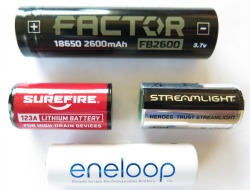
My barn full of lights run on everything from button-cell batteries to 18v rechargeable packs, but many of my EDC and bug out lights run on CR123 batteries. And if you ask to borrow a light, you will get a tube full of AA batteries. I divide my lights up across three categories: Those that will be stored for later/emergency use, those for high performance use, and those for general or anticipated use. CR123 batteries ride in my stored and high performance lights, and AA and AAA batteries ride in my general use lights.
The reason for the dichotomy is simple: cost. To get maximum performance out of a high end light, you need fresh batteries. Most modern LED lights only run their maximum output for a short time, then they step down their output according to available voltage. Finally, there will be no difference between high and low. So if you want a blinding bright blast you will need full power batteries. And since maximum output runtime is measured in minutes, every second of on now is a second of lower output later. Usually this is not a problem because the output of a high end flashlight is plenty so even halving the lumen count is still triple figures. But halve that again, and you start to sense you are at a disadvantage.
Rechargeable batteries are a great idea that is gaining more traction in the market. However, there are many nuances and persnickety flashlight circuits out there so using high-powered rechargeables is on a case-by-case basis. That said, some companies are going full on into the rechargeable side of EDC lights beyond the key fob lights. The Factor Company is pushing the edges of tactical and EDC formfactor lights including micro-USB rechargeable flashlights that can take regular batteries if needed.
It’s a Wrap
Having to bug out is never a good thing, but having proper lights solutions at hand can certainly make the difference between life and death. Whether feeling your way through a dark stairwell, or cutting corners through garbage-filled alleyways, or jumping over downed timber at night on the way to your bug out location, proper lighting is likely the first of your bug out tools to be put to the test. While some like to say the best flashlight is the flashlight in your hand, I like to say the best flashlight is the best flashlight to have in your hand. Junk can get you killed as fast or even faster than lack of experience. Lighting solutions, like firearms and survival knives must mirror your talents and expectations because when you put your life in your flashlight’s hands, you must know it’s limits as well as its dedication to your mission.

22 comments
Ok here’s what works for me. I went to ebay searched for flashlights that used a single AA battery and/or a single 14500 li-ion battery. Cost to me well under $4 each delivered, Next I ordered some 14500 batteries (cheaper if bought in bulk) for about $3 each rated at 2300mAh and a wall plug-in charger for USA about $2. Total cost for each complete unit including charger around $8. The flashlights have a high, low and strobe function. Also the flashlights have an adjustable beam width by sliding the head forward and backward. I prefer the 14500 batteries but if unavailable I can use everyday AA batteries or rechargeable AA’s and I use other peoples discarded garden solar lights to charge them (free). I modified my EDC leatherman case to more securely hold the light clip. This may not be the most powerful light but it is plenty bright and if I lose it I’ve got more. If I need a powerful light I’ve got some FOX FURY lights that will definitely blind you but they cost a lot more.
I personally prefer my $10, Black and Decker single LED, 2-AA battery flashlights! AA’s are very common and available, my headlamps use them as does my small radio; all the electronic devises I normally carry. This keeps my battery logistics very simple. Plus, I keep rechargeable AA’s and several solar battery chargers. Are the 123 batteries rechargeable? Will they be available after a SHTF event? Good Luck!
Hi Roger,
There are rechargeable 123 batteries on the market, but I’ve yet to hear about one that is a powerful, reliable, and durable as quality 123 lithiums. Some of the double-stack rechargeable options and Surefire’s solutions seem to rank pretty high both in performance and price.
I’ll be addressing the rechargeable issue in Part 2. What I do is run rechargeable AAs in my lights that are used for general purposes, but have a stockpile of Energizer AAs.
I reserve the heavy 123 lights for big duties and from when I am further away from basecamp or home. They are also in my backup bags, go bags, trucks, and anywhere else where I want a light stashed but maybe not used for years.
Frankly, I have some backup options but my philosophy here is, as I noted in my Weapons light article, to err on the side of primary use. I’ve met many a pepper who have flashlights that you shake for power (and I use the term flashlight loosely). From what I can tell, the folks with those lights in their kit have never really needed a light nor used their shake lights under serious conditions. There are better and worse ones, but any light I carry must pass the “run through the forest at night” test. Five lumens is a careful walk; 20 lumens is a cautious jog; but you need 100 lumens or more to run.
I have tested many lower priced lights and found their LED color to be too greenish (I actually have a spectrometer to measure the light’s wavelength color distribution). I’ve also found them to have significant artifacts like dark spots, lines, squares, circles, bright spots, and wildly uneven light distribution. It’s east to test for those by shining the light on white wall at various distances and slowly rotating the light looking for any observable changes. The different distances are important because the size of the artifacts vary and the brightness can mask the effect close up. One of the danger with artifacts is that they can appear as objects or movement (like a shadow moving) when the light moves (which is pretty much always).
Also the switches are a deadly weak spot that doesn’t show up until the light is pressed into service. And don’t underestimate the hardness of the lenses. Cheap plastic and glass lenses scratch, break, distort the light, and rarely keep out moisture.
LEDs are mass-produced by the thousands to millions. Cheap lights use whatever rolls off the line, while better lights high-grade the LEDs choosing the best ones based on a handful of measurable performance standards. Although high-tech, LEDs are much like lumber. Not all pieces are the same and everything that the mill makes is used somewhere and somehow. But the select boards are the best for quality projects. And the common grades go from usable to progressively worse. Same with LEDs which explains how LED lights can be given away for free as promotions and toys.
Stay tuned for part 2.
Nitecore and any panasonic (true) 123s are quality, but why use a R123 when you can use a 18650? Highly suggest you hang out on candle power forums and read a bunch on the subject. Its a great read and you’ll save some time and money with the 18650’s.
Good call on the CF forum. I used to hang with the flashaholics but slowed to a stop.
Some lights are sensitive to rechargables and circuit damage can occur. Last thing I want in my $200+ lights is fried wires.
Thanks for the info. I’ll check into it more.
Some flashlights that use two 123’s cannot accept a 18650 battery. I have some pelican and surefire that will not accept an 18650. Rechargeable Lithium 18650’s in my opinion are potentially very dangerous. Inspect them carefully before and during use. That said I do use them and am willing to accept the possible risks for the advantages they offer but I have discarded several of them.
Buy a lot of batteries could have been on the list of “Flashlight Wisdom”
Good article.
Hi Bama,
A lot of batteries might be on some lists, but remember batteries are expensive, heavy, perishable, temperamental, and inedible. Plus their care and feeding requirements cause them to go bad, discharge their power and intestines, and die when hot or cold.
I don’t advocate hoarding them unless there is a bigger plan at work, and proper storage is possible.
Personally, I look at flashlights in survival as tools that reach only a year or so in the future. Rechargeable cells maybe reach further, but I only plan on using portable electric torches to gain the initial advantage. Then when the dust settles and we know who the players are can we assess the relationship between preps and survival. So my guess is as good as yours.
Fenix E05 works great for me. 1 AAA battery 85 lumens output. Run time is 3.5 hrs I believe.
The flashlight is exactaly as long as a Chapstick. Little smaller in diameter. I carry mine on my keys. Small enough to always have it handy, bright enough to make a difference. No oddball expensive batteries either. Simple AAA. I swap in a fresh one every 3 months if I use it or not. At that rate a 4 pack of batteries lasts me all year.
Bright enough to stop someone, nope. Sure will light your way out of an office building when the power goes out. Think mine was $25.00. Going on it’s 4th year in service. Can’t say enough good things about it. Reminds me of the handgun saying a .22 in the pocket beats a .45 in the glove box. Same applies for flashlights I guess.
PS get a Dietz kerosene lantern and 5 gallons of fuel.
Save the batteries for when there really needed not daily illumination chores.
Great points here. Flashlights are so crucial to have – but there’s a lot of options out there to choose from. Thanks for sharing your insight on what you’d need!
Why rely on batteries at all? I’d go for hand cranked if possible, one thing less to try to keep up with.
sorry Pekka,
hand cranking gets old, real quick.
the hand crank lights I’m familiar with, don’t fit in my pants pockets. I often carry more than one flashlight with me, on any given day. your hands aren’t free to hold your pistol, or any other tools, while you are cranking…
the crank mechanism tends to make lots of noise, and the light goes dim at the worst of possible times. the lower quality hand crank lights may wear out before a decent set of rechargeable batteries would.
a mag lite Solitaire sells everywhere for less than ten dollars, and uses the same AAA cell. I still keep this one incandescent bulb flashlight with me, most of the time. I plan to keep one in my First-Aid Kit, too. LEDs just seem too bright when I go to check someone’s pupils. (they should both be the same size, and react the same to the light)
the main criterion I’m looking for in an EDC flashlight is the O ring seal…
I don’t want the switch contacts to be open to the air. I don’t want
“features”. I just want lots of light when I need it, and not being an ignition source is a very big plus.
Hi IDU,
From my experience, all good lights will be effectively sealed both with one or even two quality O rings at critical intersections, and durable rubberized seals over switches.
Lesser lights might have rubber coated switches and thin O rings if at all. Making a $10 light requires about $2 in materials and engineering. I think the math speaks for itself. And so do the lights.
I have been reading posts about flashlights forever and am surprised that no one ever mentions the Maglight Mag-Tac. I purchased one of these when they first came out and have been extremely pleased with it. The only thing I would have liked would have been a choice of low/high beams. It’s rugged, small and powerful.
Thanks for the feedback about the Maglight. With the dozens of lights in the space under discussion, it’s hard to address anything beyond those torches we have personal experience with. I bought into Maglight’s 3AA LED lights when they first came out but had buyers remorse once I saw what was available outside my local Home Depot.
Once high end lights were available, there was no turning back.
Thrunite t10 has been a pocket fav for me for a few months now.. This 1-AA $30.00 CAN light is a great piece of gear…. and AA batteries are much easier to find on a local store shelf….
KC
My daily pocket-carry flashlight is the Quarrow Rechargeable 40-Lumen Cap Light. I like several things about it:
* It’s small enough to fit easily in my pocket.
* It has a detachable magnetic clip, allowing one to use it as either a cap-mounted light or a small, hands-free work light.
* I can recharge it from any standard 12V vehicle socket (I use my Goal Zero Yeti 400’s 12V socket for routine recharging in the house).
* At $15, it’s inexpensive enough to buy one for EDC, plus one for my vehicle. If I so choose, I can use a 12V socket splitter to keep one charged, while running my GPS receiver.
* It has an advertised water resistance rating of IPX4 (“water splashing against the enclosure from any direction shall have no harmful effect), so rainfall shouldn’t affect it.
Of course, it does have some downsides:
* It only has a 6-hour advertised run time.
* The only way to recharge it is with a 12V socket, so many portable solar panels won’t recharge it (Goal Zero’s Nomad 13 includes a 12V socket adapter).
* At a rated output of 40 lumens, it won’t pass Doc Montana’s “run test” (but, since it’s brighter than his 20-lumen “cautious jog” assessment, it might be good enough for a healthy jog).
I like having one in the pocket and one in the socket.
I found this flashlight on ebay
https://www.ebay.com/itm/371297428380?_trksid=p2057872.m2749.l2649&ssPageName=STRK%3AMEBIDX%3AIT It has a built in stun gun and duel charging 110 and 12 volt. I just did a first test run and it still has usable light after 2 hrs. Its made by Cree and for under 20 bucks it seems like a great unit. The only issue I have is that the charging port cover doesn’t stay down, easily fixed by a wide rubber band.
Merry Christmas folks
Think about bugging out right?, why would you want the brightest Flashlight? so you can be seen with NVGs 6 miles away. oh no, so you can blind your attacker after he finds you and is about to kill you. O.K then, shouldn’t you try to be covert, remain unseen and evade the enemy? Take a LOOK at the Phantom Warrior flashlight……
if you can find one on EBAY because Phantom Warrior out of FL won’t sell to the public so this light does not get into enemy hands and our soldiers remain safe in the battlefield. This light can be undetectable with NVGs as close as 30 yards and has an average battery lifespan (4 AAs) of 150 hours to 250 hours if your light disciplined, so that could easily last you one year. With IR mode you can put on your NVGs and move in complete darkness and see up to 400 yards. bulbs are rated at 50,000 hours. waterproof to 200 ft. You can run it over with your truck. Safety lockout deters accidental turn on in your pack. THIS IS AN ITAR-RESTRICTED ITEM (SECTION 121) so it is not allowed outside the USA by law.